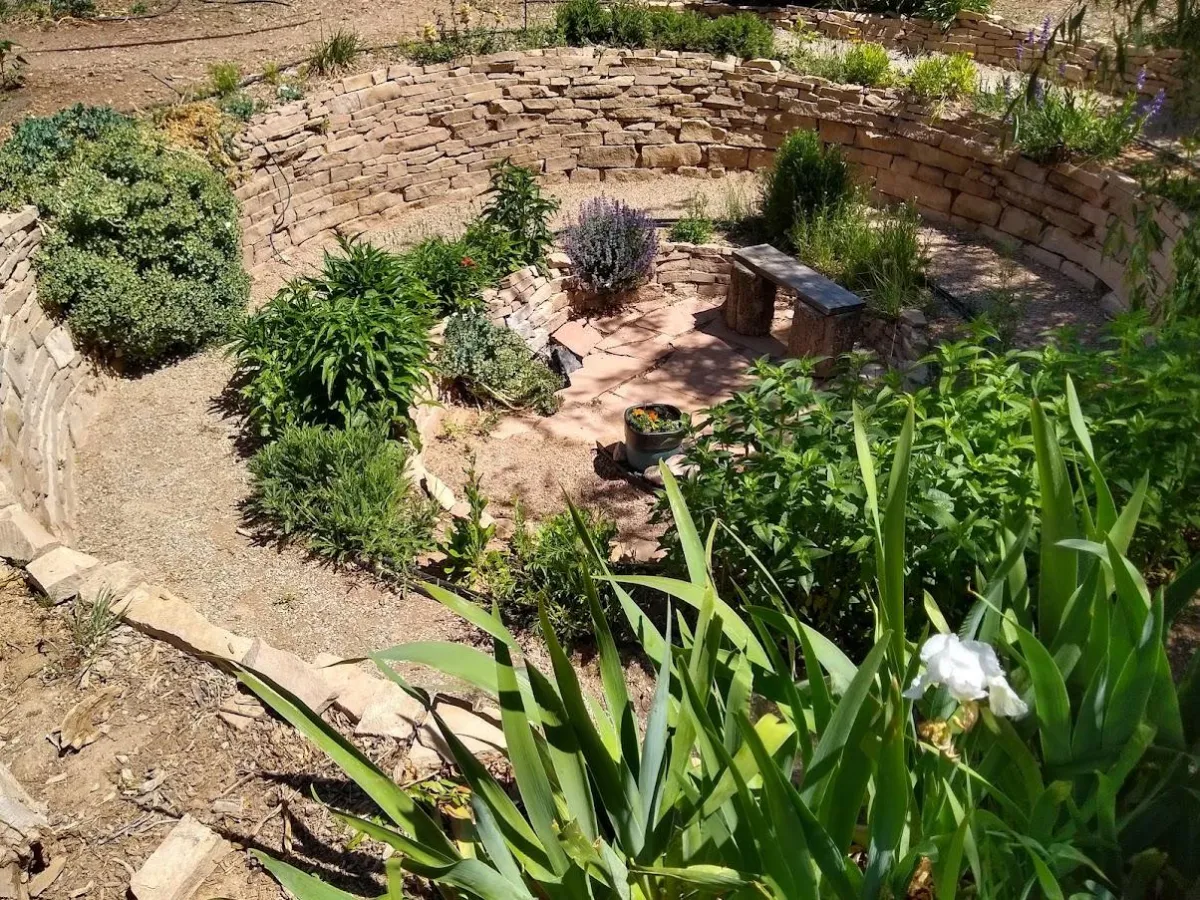
The Genesis of our Food Forest
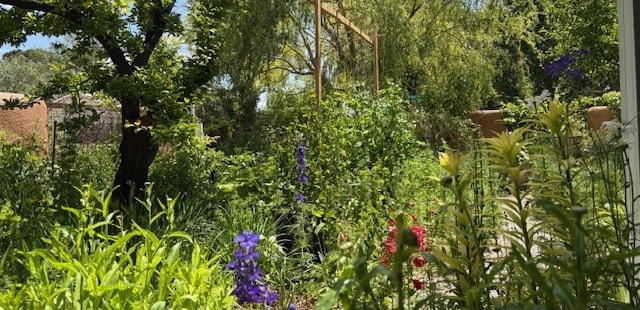
Life in the Food Forest
Our home sits in the midst of a thriving food forest in a desert environment. Solar panels provide the majority of our electricity, and a greywater system and rainwater collection help water our 23 fruit trees, plus shrubs and vines.
The Search
When my husband and I started looking for a new house in 2011, after our oldest daughter had graduated from high school, we wanted a place where she could live while she was in college and where we could develop a permaculture food forest.
Forest Garden Research
The idea of a permaculture food forest stemmed from my PhD dissertation research in Honduras. The president of Agrícola Panamericana Zamorano (Zamarano Panamerican Agricultural School) asked me to come down and do a study to determine why Hondurans didn't have home gardens and what could be done to develop home gardens in Honduras.
I quickly discovered that Hondurans did have home gardens, but they just didn't look like North American or European home gardens. There were five layers of plant life. Sweet potatoes formed a vine layer on the ground, with perennial pepper plants above them, then shrubs, small trees, and large trees. I completely rewrote my dissertation project, with only minimal communication with my major professor, and completed a survey of the food forests in Honduras.
The diversity was astounding. I found over 300 plant species, 25% food species and 10% medicinal species (at least that is how I classified the coca plants). The others, besides some beautiful flowers, included used things like luffas, bottle gourds, and even cotton plants.
I had plenty of preparation for this discovery. Before returning to school, I worked in a renewable energy project sponsored by the Land Institute and Kansas Organic Growers Association. I met my husband while managing an edible landscape and solar greenhouse for a free university, where he was the program leader for a sustainable housing project.
I had studied permaculture in preparation for my research and discovered that it had been practiced for hundreds of years in Honduras. This was in 1987, a few years before it was suggested that much of the Amazon was not wild forest but a forest garden that had been deliberately cultivated. At the time, scientists didn't believe people could have such a positive and lasting influence on their local ecosystem.
Incubation Time
I thought and planned for several years as I worked first with the New Mexico Cooperative Extension Service and then in my husband's architectural company about creating a similar multi-layer garden in the temperate region, where I would work with nature rather than try to force nature to my will.
We looked at the house we finally purchased several times before buying it, mainly because it split the yard in half, rather than having the traditional small front and large back yard. The lot is about 13,000 square feet, so it was large enough for what we wanted to do.

When we bought it, the house was 1200 square feet, and the garage/workshop was 1050 square feet. The yard was advertised as Southwest Natural, meaning nothing was growing except an occasional weed and three ancient, weak Siberian elm trees.
The Plan
We immediately began planning.
The House
We would renovate the shop as an apartment for our daughter and convert half the garage into a shop. We quickly discovered that a previous property owner had created a basement under the shop, which may have been a man cave or safe room. This made the apartment 50% larger than expected.
The Front Yard
In the front yard, we planned a rammed earth wall to stop people from walking and riding their bicycles across the front of our corner lot. The earth would come from a 4-foot deep, 28-foot diameter spiral meditation and pollinator garden providing food for butterflies, bees, and hummingbirds all year.
In the front yard, we would plant fruit trees, a shrub layer of fruit and nitrogen-fixing plants, a flowering herbaceous layer, and ground covers from the mint family. The northeast corner of the front yard would be anchored by an atlas cedar, and the south by a weeping willow, which would quickly absorb any excess water that might collect in the meditation/pollinator garden. We used permaculture principles as we planned this desert food forest.
The Backyard
The backyard would have some fruit and vegetable plantings, but would mainly be devoted to herbs for sale at farmers' markets. We would install a larger rainwater collection system. In the very back, we would have a garden shed, a chicken house, and a compost area.
The Preparation
First, we had to get permits. Because the garage and shop had been built without a permit and over the setbacks for the property, and because we wanted a kitchen in the apartment, and a tall wall in the front yard, which involved five variances and special use permits. We went to the neighborhood association before applying for anything - even before buying the property - and they were thrilled that this eyesore property at the entrance to the neighborhood would be beautifully developed.
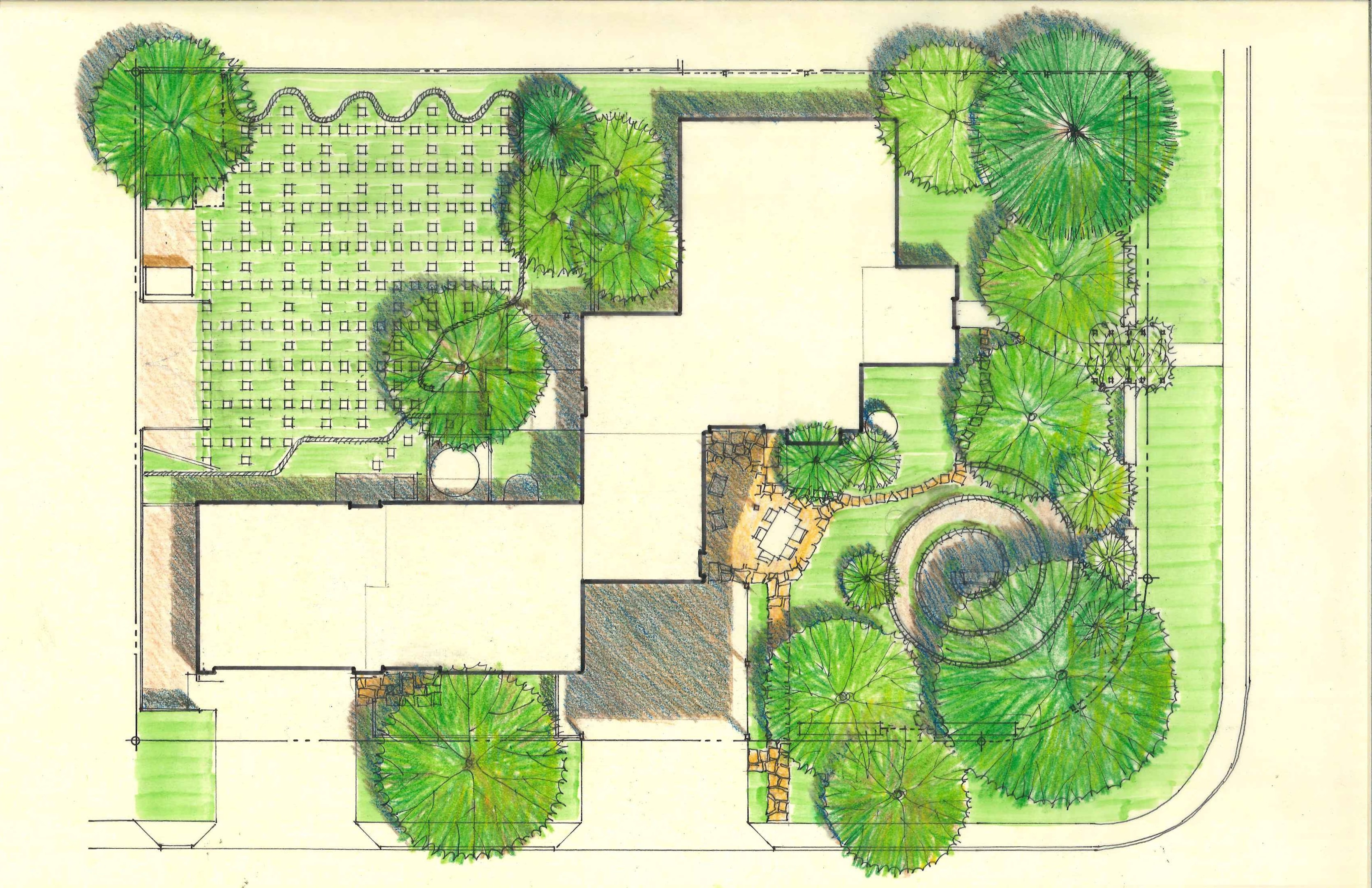
Next, my husband, the architect, visited with city planners and primed the pump for the permits and variances. We talked with the city offices involved in getting permission to use greywater and went before a couple of zoning department hearings to get everything approved. They required us to connect the two buildings under one roof, so we added a family room and a second-storey master bedroom.
We set a timeline of 5 years for the completion of the plan, and everything was approved.
Installation
We went to work on several fronts at once. My husband, our daughter, and her boyfriend went to work on the apartment. We cut down the Siberian elm trees. Our three daughters and I removed a pockmarked, green concrete patio slab that graced the back yard and dug a large hole to install an egress window in the basement, making it safer as a TV room but less of a safe room.
The Back Yard
As my next project, I reworked the contours of the backyard, creating raised beds all around it, building short retaining walls, and leveling the area that would become the herb garden.
In a corner sheltered on the south by the utility room and on the east by the dining room and a bedroom, we planted two cherry trees, an apricot tree, a pine tree, and a palm tree. The forest floor in that little bit of food forest was peppermint, which was allowed to spread as much as it wanted.
I created a scalloped vegetable garden along the north side of the yard. The scallops allow me to reach the vegetables and increase the edge, which allows more sunshine.
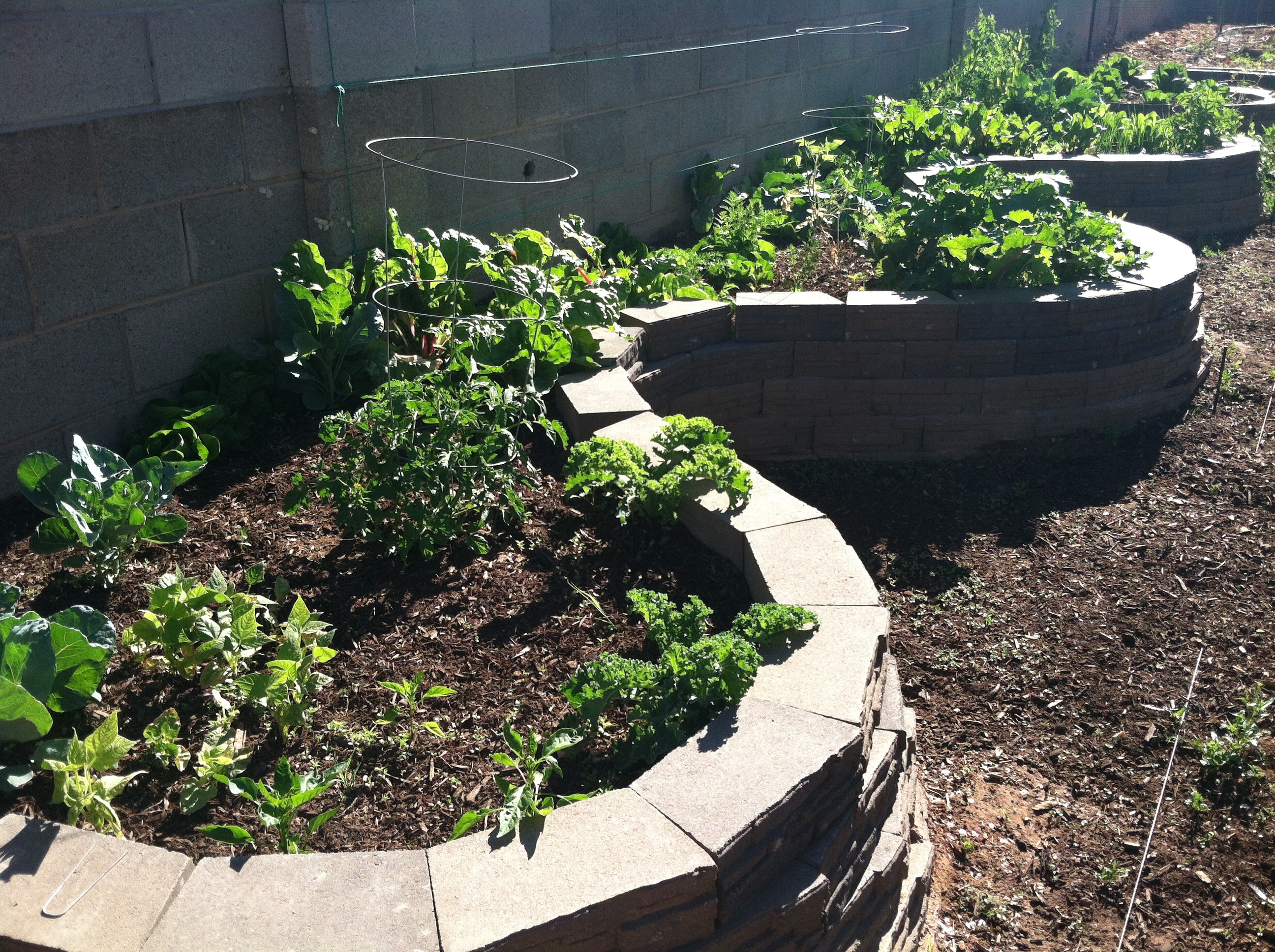
We built the chicken house, yard, and compost pile.
As we were doing this process, my mother decided she wanted to move in with us, and our youngest daughter had a child whom we later adopted. We housed my mother in the utility room until we converted the other half of the garage building, which was to have been a woodworking shop for my husband, into an apartment for my mother. We also added a greenhouse onto the south side of the apartment, requiring another variance.
We bought a large shed, placed it inside the back fence next to a wide gate and laid a slab in front of it. Two-thirds of the shed and the slab became my husband's woodshop, and one-third became my garden shed.
Next, we had to turn desert sand into healthy soil. We had a truckload of compost delivered, spread it, and tilled it in. Then, we laid out the herb garden with square pavers as stepping stones and planted every herb we thought might sell.
We installed a 600-gallon rainwater collection tank with pipes carrying water from every downspout in the backyard to the tank. We planted a Carpathian walnut tree to shade the house and provide my favorite nuts.
With the backyard taking shape, we turned to the front yard.
The Front Yard
First, we installed a greywater system using pumice wick. In this system, greywater flows into a perforated pipe in a bed of pumice, which acts as a wick to spread the water through the root zone.

The first step was to dig one-foot-wide, two-foot-deep trenches which sloped down slightly as they crossed the yard. We dug them on a ten-foot grid. Even the widest trencher we could rent would only dig a four inch wide trench, so my husband would dig a trench, I would follow along behind him and fill it in so that the wheels of the trencher would have something to support them, then he would dig a parallel trench four inchs away and we would shovel out the loose dirt. This was quite amusing to the neighbors. We were doing this in 2014, and one neighbor asked if we were commemorating the 100th anniversary of World War I by trenching our yard.
Once the trenches were dug, we lined them with weed barrier cloth. We then shoveled in six inches of pumice, laid the pipe, connecting it throughout the grid, and covered it with pumice. The weed barrier was then folded over the top, and we filled the trench with soil. The water from the showers and laundry flows into a small underground settling basin, where the solids settle out, then flows out the other side into the pumice wicks. This puts the water into the root layer of the trees. In 2025, this system is still working. We thought we might have to dig out the pumice wicks sooner or later, but they take less maintenance than expected.
A neighbor brought his backhoe over and dug out the pollinator garden, but my husband's marks on the ground quickly disappeared, so he dug out only about half of it. With our infant granddaughter watching from the stroller, we finished the digging by hand. Neighbors stopped by and asked what we were doing, and several joined in the digging process. It was a great way to get to know the neighbors.

Once we had the spiral path formed and the big pile of dirt next to it, we called the contractor with the forms for the rammed earth wall. He was willing to rent the forms to us for $10,000. That did not include any labor or equipment. We priced building our forms and renting the equipment, and decided a straw bale wall would be more practical. We put a sign Free Dirt on our big pile, and got to know quite a few other people as they came to haul away our fill dirt.
The city would not let us put a solid wall around our front yard, but they did allow a wall with open trellises every ten feet, so we had a straw bale contractor build five sections of wall and put trellises between them. On two of them we planted grapes, one holds up a honeysuckle, and one a clematis.
Outside the wall, we focused on native plants and Jerusalem artichokes on the south side, blackberries, and espalier apple and pear trees on the east. The blackberries failed, so we went to wolfberries, a local type of goji berry, and a few other native plants. Inside the wall, I planted sunflowers as a background plant. These soon spread to the outside of the wall, and sunflowers took over anywhere there was irrigation. They reseed themselves every year now.
Planting the Food Forest
Finally, we began planting the main part of our food forest.
Mediterranean Ecosystem
On the south side of the house, we planted a Mediterranean community. The ground cover layer consists of oregano and some spreading, hardy succulents. The herbaceous layer includes salvia, snapdragons, some poppies that reseed themselves all over the garden, and sometimes zinnias. There is a rosemary shrub, a pomegranate, grape vines, a fig tree, an apple tree, and an ornamental pear.
Pollinator Garden
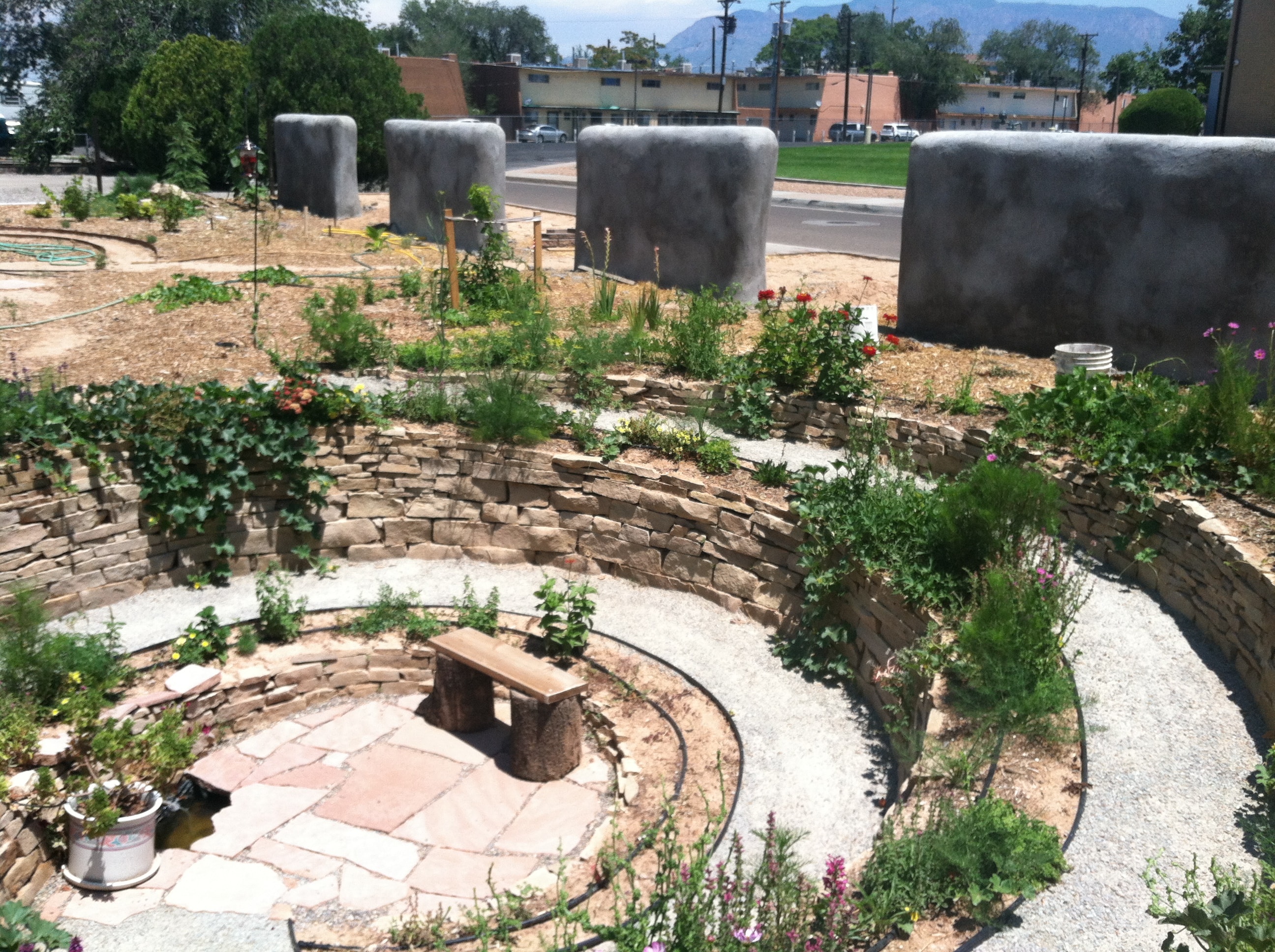
The pollinator spiral is to the east of this area, surrounded by a willow tree, two elderberry shrubs, and a butterfly bush. Perennial plants include catmint, coneflowers, coreopsis, snapdragons, yarrow and penstemons. I add new plants every summer. The annuals I add have changed as the willow tree has grown and the forest garden has become shadier.
Peach and Plum
We have a peach and a plum tree to the north of the pollinator garden. The perennial understory here includes wintergreen, wild geraniums, and a variety of bulbs. There is also a raised bed where we rotate vegetable crops. A crepe myrtle shrub adds some color after the fruit trees have finished blooming.
Iris, Daylilies and Dahlias
The iris, daylily, and dahlia beds, a bright selection of flowers outside our sunroom, are across the path to the west of the fruit trees. This is the one sunny space in the front yard, and if we need space to grow food crops, I could change it, but I do really like the flowers.
Our Mountain Region
Finally, in the northeast corner of the yard, we have a diverse selection of trees and shrubs, with the Atlas cedar in the corner. This area, which we call the glade, is where a patch of pennyroyal groundcover is surrounded by columbines, Nanking cherry shrubs, a Siberian pea shrub, a redbud, and a sour cherry tree.
Once all of these plants became established, they formed a lush forest garden that attracts beneficial insects, provides habitat for various bird species and other small wildlife, and provides us with significant amounts of food and a cool, shady yard we can enjoy year-round.
Evolution
Cash Crops
As time passed, we discovered that fresh herbs did not sell well at the farmers' markets, and our granddaughter needed a place to play, so we turned the herb garden into a lawn. Until the farmers' market that met in the park across the street closed, we did well selling flowers, Swiss Chard, and whatever extra fruit we had.
Increased Shade
The pollinator garden is now mostly in the shade. I have planted lily of the valley, begonias, coleus, and hosta in place of the marigolds, zinnias, and lisianthus I used to plant. I have also added sun-loving plants to other areas of the garden.
Back Yard
The walnut tree died because it wasn't quite cold hardy enough for our climate, so we planted an almond tree instead, which provides more nuts than we need. I have also changed from peppermint under the cherry and apricot trees to a tea garden where I grow peppermint, spearming, lemon balm, catnip, chamomile, lavender, and stevia.
More information: To learn more about some of the principals, check out the book Gaia's Garden here.
(As an Amazon Affiliate I may receive payment for purchases made through this link.)
